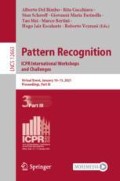Abstract
Machine learning is currently successfully used for addressing several cybersecurity detection and classification tasks. Typically, such detectors are modeled through complex learning algorithms employing a wide variety of features. Although these settings allow achieving considerable performances, gaining insights on the learned knowledge turns out to be a hard task. To address this issue, research efforts on the interpretability of machine learning approaches to cybersecurity tasks is currently rising. In particular, relying on explanations could improve prevention and detection capabilities since they could help human experts to find out the distinctive features that truly characterize malware attacks. In this perspective, Android ransomware represents a serious threat. Leveraging state-of-the-art explanation techniques, we present a first approach that enables the identification of the most influential discriminative features for ransomware characterization. We propose strategies to adopt explanation techniques appropriately and describe ransomware families and their evolution over time. Reported results suggest that our proposal can help cyber threat intelligence teams in the early detection of new ransomware families, and could be applicable to other malware detection systems through the identification of their distinctive features.
Access this chapter
Tax calculation will be finalised at checkout
Purchases are for personal use only
Notes
- 1.
MD5: 8a7fea6a5279e8f64a56aa192d2e7cf0.
References
Adadi, A., Berrada, M.: Peeking inside the black-box: a survey on explainable artificial intelligence (XAI). IEEE Access 6, 52138–52160 (2018). https://doi.org/10.1109/ACCESS.2018.2870052
Adebayo, J., Gilmer, J., Muelly, M., Goodfellow, I., Hardt, M., Kim, B.: Sanity checks for saliency maps. In: Advances in Neural Information Processing Systems 31, pp. 9505–9515. Curran Associates, Inc., October 2018
Alber, M., et al.: iNNvestigate neural networks! August 2018. http://arxiv.org/abs/1808.04260
Ancona, M.: DeepExplain. https://github.com/marcoancona/DeepExplain
Ancona, M., Ceolini, E., Öztireli, C., Gross, M.: Gradient-based attribution methods. In: Samek, W., Montavon, G., Vedaldi, A., Hansen, L.K., Müller, K.-R. (eds.) Explainable AI: Interpreting, Explaining and Visualizing Deep Learning. LNCS (LNAI), vol. 11700, pp. 169–191. Springer, Cham (2019). https://doi.org/10.1007/978-3-030-28954-6_9
Barredo Arrieta, A., et al.: Explainable Artificial Intelligence (XAI): concepts, taxonomies, opportunities and challenges toward responsible AI. Inf. Fusion 58(2019), 82–115 (2020). https://doi.org/10.1016/j.inffus.2019.12.012
Demetrio, L., Biggio, B., Lagorio, G., Roli, F., Armando, A.: Explaining vulnerabilities of deep learning to adversarial malware binaries. In: Proceedings of the Third Italian Conference on Cyber Security 2019. CEUR-WS.org, Pisa, February 2019
Ghorbani, A., Wexler, J., Zou, J., Kim, B.: Towards automatic concept-based explanations. In: Advances in Neural Information Processing Systems. pp. 9273–9282. Curran Associates Inc., Vancouver, February 2019
Ilyas, A., Santurkar, S., Tsipras, D., Engstrom, L., Tran, B., Madry, A.: Adversarial examples are not bugs, they are features. In: Advances in Neural Information Processing Systems 32 (NIPS 2019), pp. 125–136. Curran Associates Inc., Vancouver (2019)
Kim, B., et al.: Interpretability beyond feature attribution: quantitative testing with concept activation vectors (TCAV). In: 35th International Conference on Machine Learning (ICML 2018), vol. 80, pp. 2668–2677. Stockholm, July 2018
Lage, I., et al.: An evaluation of the human-interpretability of explanation. In: Proceedings of the AAAI Conference on Human Computation and Crowdsourcing, vol. 7, pp. 59–67. AAAI Press, Honolulu, January 2019
Lipton, Z.C.: The mythos of model interpretability. Queue 16(3), 31–57 (2018). https://doi.org/10.1145/3236386.3241340
Maiorca, D., Mercaldo, F., Giacinto, G., Visaggio, C.A., Martinelli, F.: R-PackDroid: API package-based characterization and detection of mobile ransomware. In: Proceedings of the Symposium on Applied Computing - SAC ’17, pp. 1718–1723. ACM Press, New York (2017). https://doi.org/10.1145/3019612.3019793, http://dl.acm.org/citation.cfm?doid=3019612.3019793
Melis, M., Demontis, A., Pintor, M., Sotgiu, A., Biggio, B.: secml: a python library for secure and explainable machine learning. arXiv preprint arXiv:1912.10013 (12 2019). http://arxiv.org/abs/1912.10013
Pendlebury, F., Pierazzi, F., Jordaney, R., Kinder, J., Cavallaro, L.: TESSERACT: eliminating experimental bias in malware classification across space and time. In: 28th USENIX Security Symposium (USENIX Security 19), pp. 729–746. USENIX Association, Santa Clara, August 2019
Preece, A., Harborne, D., Braines, D., Tomsett, R., Chakraborty, S.: Stakeholders in explainable AI. In: AAAI Fall Symposium on Artificial Intelligence in Government and Public Sector. Arlington, Virginia, USA (2018)
Scalas, M., Maiorca, D., Mercaldo, F., Visaggio, C.A., Martinelli, F., Giacinto, G.: On the effectiveness of system API-related information for Android ransomware detection. Comput. Secur. 86, 168–182 (2019). https://doi.org/10.1016/j.cose.2019.06.004, https://linkinghub.elsevier.com/retrieve/pii/S0167404819301178
Sebastián, M., Rivera, R., Kotzias, P., Caballero, J.: AVclass: a tool for massive malware labeling. In: Monrose, F., Dacier, M., Blanc, G., Garcia-Alfaro, J. (eds.) RAID 2016. LNCS, vol. 9854, pp. 230–253. Springer, Cham (2016). https://doi.org/10.1007/978-3-319-45719-2_11
Shrikumar, A., Greenside, P., Shcherbina, A., Kundaje, A., Shcherbina, A., Kundaje, A.: Not just a black box: learning important features through propagating activation differences. In: 34th International Conference on Machine Learning, ICML 2017, vol. 7, pp. 4844–4866. JMLR.org, Sydney, NSW, Australia, May 2016. https://doi.org/10.5555/3305890.3306006
Sundararajan, M., Taly, A., Yan, Q.: Axiomatic attribution for deep networks. In: Proceedings of the 34th International Conference on Machine Learning, pp. 3319–3328. JMLR.org, Sidney, March 2017. http://arxiv.org/abs/1703.01365
Warnecke, A., Arp, D., Wressnegger, C., Rieck, K.: Evaluating explanation methods for deep learning in security. In: 5th IEEE European Symposium on Security and Privacy (Euro S&P 2020), Genova, September 2020
Author information
Authors and Affiliations
Corresponding author
Editor information
Editors and Affiliations
Rights and permissions
Copyright information
© 2021 Springer Nature Switzerland AG
About this paper
Cite this paper
Scalas, M., Rieck, K., Giacinto, G. (2021). Explanation-Driven Characterization of Android Ransomware. In: Del Bimbo, A., et al. Pattern Recognition. ICPR International Workshops and Challenges. ICPR 2021. Lecture Notes in Computer Science(), vol 12663. Springer, Cham. https://doi.org/10.1007/978-3-030-68796-0_17
Download citation
DOI: https://doi.org/10.1007/978-3-030-68796-0_17
Published:
Publisher Name: Springer, Cham
Print ISBN: 978-3-030-68795-3
Online ISBN: 978-3-030-68796-0
eBook Packages: Computer ScienceComputer Science (R0)


